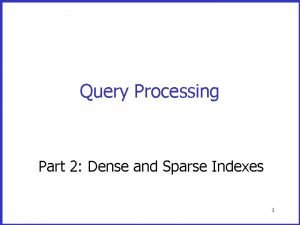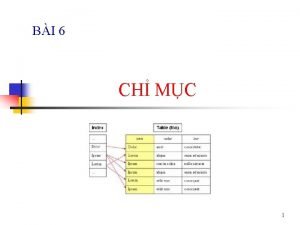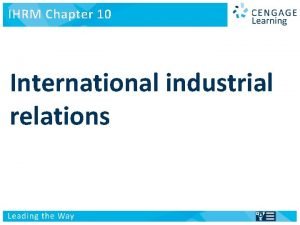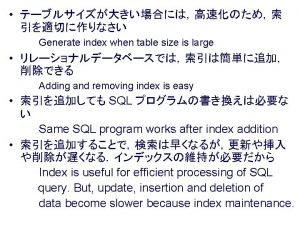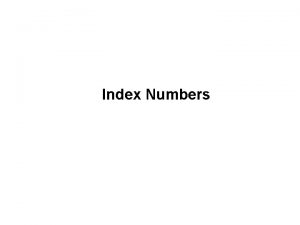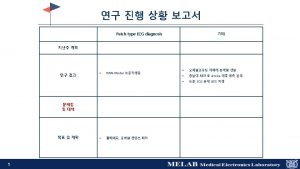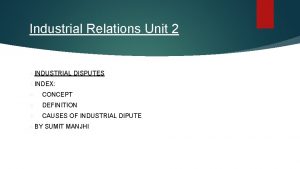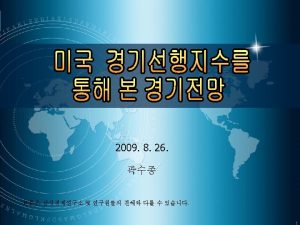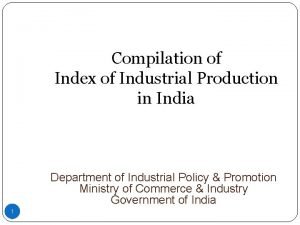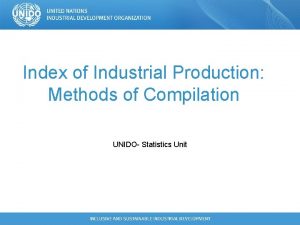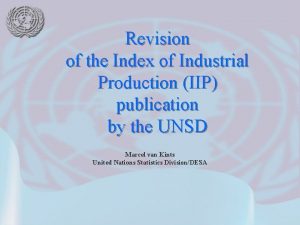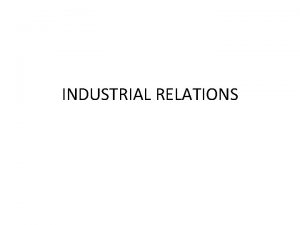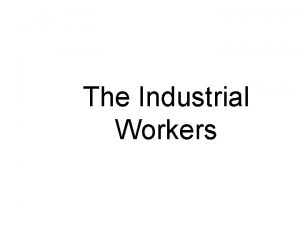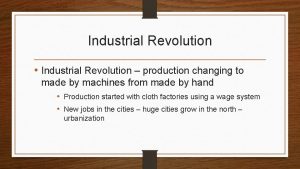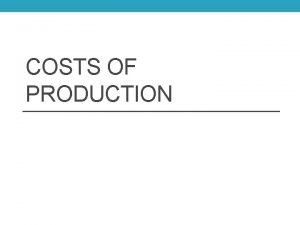International Recommendations for the Index of Industrial Production






























- Slides: 30

International Recommendations for the Index of Industrial Production (IIP) United Nations Statistics Division/DESA

History o Index of Industrial Production has been calculated since the 1920 s n UNSD has collected series going back to 1938 o Methodology was described in 1950 UN Manual on “Index of industrial production” n Number 1 in series of publications on international recommendations and guidelines (Series F)

History o The 1950 manual was not updated o However, related guidance materials were published: n Guidelines on Principles of a System of Price and Quantity Statistics, 1977 n Manual on Producers’ Price Indices for Industrial Goods, 1979

History o Why a revision of the IIP publication? n The previous UN publication on the IIP was published in 1950 n Methods and approaches have changed over time (e. g. fixed weight vs. chain approaches, volume aggregation vs. deflation, etc. )

History o Why a revision of the IIP publication? n Various related standards and international recommendations have been updated over time: o International Recommendations for Industrial Statistics 2008 o System of National Accounts 2008 o Producer Price Index Manual o Classifications (ISIC Rev. 4, CPC ver. 2) n These changes need to be reflected in the updated IIP text

Publication structure o Part I includes a description of the international recommendations, covering scope, fundamental concepts, etc. n It is encouraged that countries comply with the recommendations set out in Part I. o Part II includes international guidance to assist countries in implementing these recommendations n It presents a set of methods (categorized as ‘preferred’, ‘alternative’ and ‘other’) and variables for each ISIC Rev. 4 class in scope of this publication for the compilation of an IIP, based on current country practices

Key issues/recommendations o 1: Statistical units, classifications & business register n Recommendations outlining - Statistical Units to use; classifications; use of business registers; and data sources (incl. administrative data sources). o 2: Frequency n Publication recommends monthly compilation of the IIP so that turning points in economic activity can be identified as early as possible

Key issues/recommendations o 3: Scope of the IIP: n Scope is defined to cover activities in sections B - E of ISIC Rev. 4, i. e. Mining and quarrying, Manufacturing, Electricity, gas steam and airconditioning supply, as well as water supply, sewerage, waste management and remediation activities o Section E contains new areas for inclusion in the IIP o This scope coincides with the scope of the International Recommendations for Industrial Statistics (IRIS) 2008, which includes the index numbers of industrial production in its list of recommended indicators

Key issues/recommendations o 4: Index formula n Laspeyres index is recommended o Preferred due to feasibility over Paasche or Fischer index n Chain linked, rather than fixed base indices are recommended o 5: Weights and updates n Annual update of weights should be carried out to provide an up-to-date weighting structure for the index. n Weights should ideally be National Accounts value added figures – adjustments necessary to make them timely available.

Key issues/recommendations o 6: Calculation method n Deflation should be used to obtain volume estimates from value data, rather than volume extrapolation method n PPI is recommended as deflator n Deflation should be done at lowest level, i. e. 4 digit industry level n Volume aggregation still works for areas with limited number of products.

Key issues/recommendations o 7. Variables to be used n To approximate industrial production for the IIP, output measures (value or physical quantity of output) are preferred over input measures (labour or materials consumed) o E. g. relationship between labour and production value is affected by various factors, including quality, efficiency etc. n The publication provides suggestions for preferred, alternate and other methods for the use of variables in the IIP calculation. o Suggestions are specific for each ISIC industry at 4 -digit level

Key issues/recommendations o 8: Data adjustments n Adjustments should be made for quality changes o Either through the correction of PPI used in deflation, or o by adjusting input data when volume aggregation is used n Data series should be produced as work day adjusted as well as seasonal adjusted series

Key issues/recommendations o 9: Dissemination n The publication outlines elements / requirements for the dissemination of IIP data n General requirements for international reporting are set in the International Recommendations for Industrial Statistics (IRIS) 2008 n UNSD data collection will continue at 2 -digit ISIC level for annual and quarterly data, 1 -digit ISIC level for monthly data o Currently for raw (unadjusted) data only o Will switch to ISIC Rev. 4 for production of regional IIP

Major changes o Scope n Enlarged definition of “industry” o Recommended calculation method n Deflation vs. volume extrapolation o Frequency of weight updates n Annual updates vs. 5 -yearly updates n Chain linking vs. fixed-weight approach o Other recommendations, such as on seasonal adjustment or dissemination issues reflect an update of previous recommendations as well

Two main approaches to calculate the IIP

Purpose of the IIP o Purpose: to reflect the volume developments in value added over time o Difficult: impossible to calculate value added at high frequency and with appropriate timeliness o Solution: to obtain the best approximation of short-term movements in value added

Goal o Measure volume changes over time n The measurement should not reflect price changes in the measurement period

Options o 1) Build a measurement that uses only volume changes at detailed level n “Volume extrapolation” o 2) Use a price deflator to remove the price component from an overall value measure, isolating the volume component n “Deflation”

Recommended approach o The 1950 IIP manual relied on the volume extrapolation approach o The 2010 IIP manual recommends mostly the deflation method n Recommendations depend on industry (see chapter 7)

What separates the two approaches? o Calculation method (formula) o Data requirements n Data availability o Work load o Stability, ability to adapt

Volume extrapolation o concept : utilize the movements in volumes directly to calculate an IIP o suitable : volume variables o formula : IIP=Q 1/Q 0 (at elementary/product level) n Use weights to aggregate to higher levels

Volume extrapolation o Possible input data: n Output variables o Physical quantity of output (at individual product n Input variables o Labor input o Materials consumed o While input data are sometimes easier to obtain, they assume a fixed relationship between input and output

Volume extrapolation o Data requirements n Data need to be available for a detailed set of products o Volume extrapolation starts at the product level, then aggregates through product groups and industries n Products have to be representative for the respective industries fro which the IIP is compiled o Work load n High due to need for detailed product data (collection and processing)

Volume extrapolation o Stability n In some areas, shifting of production between products (or product groups) can negatively influence the data quality o Example: pharmaceuticals o Ability to adapt n Difficult to account for quality changes

Deflation method o concept : isolate the volume component from value variables o suitable : value variables o formula : IIP=(Value 1/Price index) / Value 0 =(∑P 1 Q 1/Price Index) / ∑P 0 Q 0 o At level where price index is available

Deflation method o Possible input data: n Output variables: o Value of output sold n Needed only at more aggregated level than data for volume extrapolation

Deflation method o Data requirements n Data need to be available only at a higher level of aggregation n BUT: “Appropriate” deflator (price index) needs to be available at this level too n Deflation should take place at lowest level possible o Typically: 4 -digit ISIC level; could be product group level

Deflation method o Work load n Reduced (less detailed data collection and processing) n BUT: price index needs to be calculated o Responsibility shifts to another area o “Duplication” of work can be avoided

Deflation method o Stability n Price movements are more stable than quantity movements in many areas n Deflation provides a better tool (while investing same amount of work) to calculate IIP for areas with frequently/seasonally shifting product patterns o Ability to adapt n Quality effects are accounted for in the deflator (price index)

Recommendation o The IRIIP 2010 recommends the deflation method as the preferred approach to calculation of the IIP o Exceptions are made by industry, e. g. if only a small set of products exist and if quality changes are not a major concern n Chapter 7 of the publication provides recommendations by industry, including choice of variables
 Post production adalah
Post production adalah Index of industrial production formula
Index of industrial production formula Reticulocyte count calculator
Reticulocyte count calculator Miller disc
Miller disc Reticulocyte production index
Reticulocyte production index Diff between step index and graded index fiber
Diff between step index and graded index fiber Dense index vs sparse index
Dense index vs sparse index Eryhtema
Eryhtema Compare india and sri lanka on the basis of hdi
Compare india and sri lanka on the basis of hdi Single mode fiber supports meridional rays
Single mode fiber supports meridional rays Simpsons evenness
Simpsons evenness Liquid limit of soil formula
Liquid limit of soil formula Clustered index và non clustered index
Clustered index và non clustered index Industrial park planning and design
Industrial park planning and design International industrial relations in ihrm
International industrial relations in ihrm Iso 22301 utbildning
Iso 22301 utbildning Typiska drag för en novell
Typiska drag för en novell Nationell inriktning för artificiell intelligens
Nationell inriktning för artificiell intelligens Returpilarna
Returpilarna Shingelfrisyren
Shingelfrisyren En lathund för arbete med kontinuitetshantering
En lathund för arbete med kontinuitetshantering Kassaregister ideell förening
Kassaregister ideell förening Personlig tidbok för yrkesförare
Personlig tidbok för yrkesförare Anatomi organ reproduksi
Anatomi organ reproduksi Vad är densitet
Vad är densitet Datorkunskap för nybörjare
Datorkunskap för nybörjare Boverket ka
Boverket ka Mall debattartikel
Mall debattartikel Autokratiskt ledarskap
Autokratiskt ledarskap Nyckelkompetenser för livslångt lärande
Nyckelkompetenser för livslångt lärande Påbyggnader för flakfordon
Påbyggnader för flakfordon






